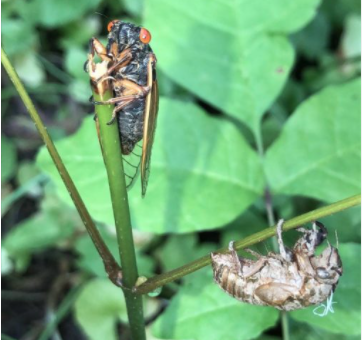Cicada Chaos

Every 17 years millions of little bugs emerge from the earth. These insects are called cicadas and each group or “brood” of them emerges on a set interval. The last time the cicadas swarmed Ohio was in 2004, meaning it’s time for a reappearance.
The first thing people should know about cicadas is that they do not bite or sting. Many are afraid, but they won’t hurt you. Their only defense is the colossal amount of them that travel together. They make a very distinct noise as well, a special organ called a tymbal, that produces a buzzing sound by a series of ribs that are clicked together when the cicada clenches certain muscles.
2021’s swarm will cover a large area reaching into 15 states, including Pennsylvania, Ohio, Kentucky, Indiana, Delaware, Illinois, Georgia, Maryland, Michigan, New Jersey, New York, North Carolina, Virginia, West Virginia and Tennessee. Southwest Ohio is among the places predicted to have a very high number of Cicadas. Nearly all of Indiana is bound to have trillions of cicadas and up to 1.5 million per acre.
Many shops and restaurants have claimed they will be shutting down during Brood X 2021’s hatch to battle the countless amount of cicadas. If you’re worried about them getting into your home or into your belongings, make sure to patch small holes that may lead to the outdoors. Cover up your outside furniture so that shells will not be left all over them. To have less cicada activity in general you should prune your trees before they hatch. This is effective because they need plants and leaves to lay their eggs on.
According to Cicadamania.com, “After the long wait underground the cicadas emerge and will climb the closest vertical surface (usually a plant) and begin to shed off their exoskeleton. Now that they are free of their old skin their wings will begin to fill with fluid and their new skin hardens. The land may be littered with little cicada shells, but don’t be afraid to pick one up and take a look. cicadas are considered to be mostly beneficial to the environment. They prune mature trees making them more healthy, they aerate the soil and when they die their bodies give an important source of nitrogen for growing trees.”
Cicadas can live 2-17 years underground before they emerge and shed their shell. During this time period underground they are burrowing and making tunnels. The weather is a big factor in the time that the cicadas emerge because they prefer a warmer ground temperature before hatching. The ideal temperature is 64 degrees.
The next batch of cicadas are officially here and Ross gets a first-hand view. Even if millions of bugs flying are not your thing, take the listed precautions to keep them away and you can stay inside and admire their unique sounds before we wait another 17 years.





